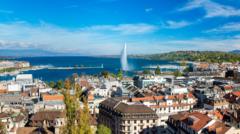As Switzerland positions itself as a playground for the world's elite, the economy thrives but local residents face challenges amid rising prices and accommodation shortages.
Luxury Tourism in Switzerland: Navigating Wealth and Local Concerns

Luxury Tourism in Switzerland: Navigating Wealth and Local Concerns
Switzerland's burgeoning luxury tourism sector raises questions about its broader implications for local communities.
Switzerland has long been synonymous with luxury tourism, attracting wealthy clientele from the U.S., Gulf states, and rapidly emerging markets like China and India. Despite ongoing global uncertainties, the trend toward opulent experiences remains strong; five-star hotels in the Alps have become increasingly popular, leading to a spike in both new constructions and renovations of historic establishments.
Prominent hotels such as the Badrutt's Palace in St. Moritz epitomize this upscale appeal, offering extravagant amenities like personal ski butlers and gourmet dining in breathtaking settings. Swiss hoteliers emphasize quality over price, catering to discerning guests who expect top-notch service. In this landscape, it is not surprising that guests in luxury hotels contribute a disproportionate amount—nearly 25%—to the nation's tourism revenue with only 8% of total overnight stays.
However, the explosion of luxury accommodations also brings into sharp focus the plight of local residents. Many alpine communities find themselves grappling with issues of affordability, as rising rents and cost of living push service workers further away from their jobs. Some hotel staff must travel long distances for affordable housing, leaving them navigating late-night commutes after long shifts.
This dichotomy between economic benefit and community strain raises important questions for tourism experts. Monika Bandi, head of the Tourism Research Unit at Bern University's Centre for Regional Development, suggests a careful appraisal is needed, balancing quantity with quality. Too many tourists may dilute the distinct character of these traditional destinations.
In the renowned resort of Wengen, plans for its first five-star hotel have ignited a debate about community integration, with local heritage advocates expressing concern over the potential transformation of the town’s identity. Opponents of the new developments suggest that these luxury projects may prioritize financial gain over community welfare, fearing that shallow tourist engagement could lead to a loss of local charm.
Nonetheless, some officials argue that Wengen has managed to retain its unique atmosphere—even amidst the luxury boom. Accessible only by train, the locale approaches tourism with a blend of tradition and innovation, aiming to cater to affluent travelers without alienating non-wealthy visitors.
The Swiss tourism strategy encapsulates the idea of enhancing quality of life through luxury expenditures while keeping a diverse range of services available for all income levels. As they tread this delicate path, the key challenge remains ensuring that local communities can thrive alongside the emerging "playground for the rich" without losing their identity or accessibility.
In the end, Switzerland’s luxury tourism strategy is balancing precariously on the tightrope of wealth generation and the preservation of community character. The country seems to be banking on the notion that cultivating a market for the affluent can coexist with supporting diverse and sustainable tourism practices. Whether this dream will realize or dissolve remains the pressing question ahead.
Prominent hotels such as the Badrutt's Palace in St. Moritz epitomize this upscale appeal, offering extravagant amenities like personal ski butlers and gourmet dining in breathtaking settings. Swiss hoteliers emphasize quality over price, catering to discerning guests who expect top-notch service. In this landscape, it is not surprising that guests in luxury hotels contribute a disproportionate amount—nearly 25%—to the nation's tourism revenue with only 8% of total overnight stays.
However, the explosion of luxury accommodations also brings into sharp focus the plight of local residents. Many alpine communities find themselves grappling with issues of affordability, as rising rents and cost of living push service workers further away from their jobs. Some hotel staff must travel long distances for affordable housing, leaving them navigating late-night commutes after long shifts.
This dichotomy between economic benefit and community strain raises important questions for tourism experts. Monika Bandi, head of the Tourism Research Unit at Bern University's Centre for Regional Development, suggests a careful appraisal is needed, balancing quantity with quality. Too many tourists may dilute the distinct character of these traditional destinations.
In the renowned resort of Wengen, plans for its first five-star hotel have ignited a debate about community integration, with local heritage advocates expressing concern over the potential transformation of the town’s identity. Opponents of the new developments suggest that these luxury projects may prioritize financial gain over community welfare, fearing that shallow tourist engagement could lead to a loss of local charm.
Nonetheless, some officials argue that Wengen has managed to retain its unique atmosphere—even amidst the luxury boom. Accessible only by train, the locale approaches tourism with a blend of tradition and innovation, aiming to cater to affluent travelers without alienating non-wealthy visitors.
The Swiss tourism strategy encapsulates the idea of enhancing quality of life through luxury expenditures while keeping a diverse range of services available for all income levels. As they tread this delicate path, the key challenge remains ensuring that local communities can thrive alongside the emerging "playground for the rich" without losing their identity or accessibility.
In the end, Switzerland’s luxury tourism strategy is balancing precariously on the tightrope of wealth generation and the preservation of community character. The country seems to be banking on the notion that cultivating a market for the affluent can coexist with supporting diverse and sustainable tourism practices. Whether this dream will realize or dissolve remains the pressing question ahead.




















